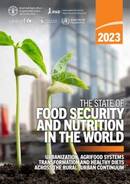Publications
Urbanization is changing agrifood systems globally in ways that can only be understood through a rural–urban continuum lens. The changing pattern of population agglomerations across a rural–urban continuum and its interface as a place of exchange and socioeconomic interactions, is reshaping and being reshaped by agrifood systems, with implications for the availability and affordability of healthy diets, and in turn, for food security and nutrition.
The Status of Women in Agrifood Systems report provides the latest data, lessons learned and recommendations for policy and decision makers about gender in agrifood systems. It eviews and analyzes women’s opportunities and constraints in economic and social processes, while taking stock and assessing progress made in closing a series of gender gaps. It provides compelling examples of policies and programmes with a review of what has worked, and specific recommendations about how to do more, and better. The brief summarizes the key messages and findings.
FAO’s Committee on Agriculture requested a comprehensive, science- and evidence-based global assessment of the contribution of livestock to food security, sustainable food systems, nutrition and healthy diets, considering environmental, economic and social sustainability. The assessment consists of four component documents. This first component document provides a holistic analysis of the contribution of terrestrial animal source food to healthy diets for improved nutrition and health outcomes over the course of people’s lives.
Agrifood system transformation to achieve the Sustainable Development Goals requires increased attention to developing, adapting and diffusing impactful science, technology and innovation (STI). Current levels and patterns of STI uptake are inadequate to facilitate needed agrifood system transformations, especially in today's low- and middle-income countries. Moreover, the descriptive and evaluative evidence on current and emergent STI is also insufficiently well understood to permit intentional management of STI to meet the multiple objectives of future agrifood systems: efficient, inclusive, resilient and sustainable. This report introduces the vision, rationale, scope and methods for new knowledge products FAO will launch as part of a new Agrifood System Technologies and Innovations Outlook (ATIO). ATIO's objective is to curate existing information on the current, measurable state of STI and upcoming changes, as well as their transformative potential, to inform evidence-based policy dialogue and decisions, including on investments.
The State of Food and Agriculture 2022 looks into the drivers of agricultural automation, including the more recent digital technologies. Based on 27 case studies, the report analyses the business case for adoption of digital automation technologies in different agricultural production systems across the world. It identifies several barriers preventing inclusive adoption of these technologies, particularly by small-scale producers. Key barriers are low digital literacy and lack of an enabling infrastructure, such as connectivity and access to electricity, in addition to financial constraints. Based on the analysis, the publication suggests policies to ensure that disadvantaged groups in developing regions can benefit from agricultural automation and that automation contributes to sustainable and resilient agrifood systems.






